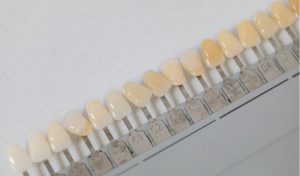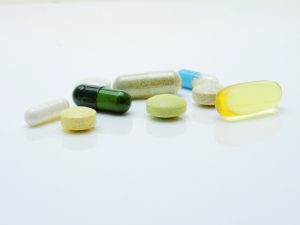Tooth discolouration
The Yellow, dark green or brownish appearance of teeth is usually caused by the process called teeth discolouration. Generally, there are two types of discolouration: intrinsic and extrinsic discolouration. Intrinsic discolouration occurs when the thickness or structure of the tooth layers changes. Extrinsic discolouration is happening outside the tooth and it usually lays on the tooth [1]. For a better understanding of how this works, it is good to know the basic structure of the tooth.

What does a tooth consist of?
A tooth consists of multiple layers but generally, we speak about 2 parts; the inner and outer part. The inner part is called dentin and it is rich in proteins. Besides, it contains 70% of calcium phosphate in the form of hydroxyapatite. The outer part of the tooth, called enamel, is a mineralized tissue containing about 97% hydroxyapatite[1].
Ageing
Hydroxyapatite is therefore the main component of a tooth. It is colourless/white. The outer part of a tooth (enamel) has a white colour but by rising age, it becomes worn out and therefore tinier. That makes dentin (the inner part of the tooth) to become more visible. The more visible is the dentin, the darker is the appearance of teeth [2]. This process is known as one of the types of intrinsic discolouration. As a result, with growing age, the appearance of the teeth gets darker and more yellow [2].

Medication
In addition, teeth can be discoloured and therefore looking dark or yellow by using certain types of medication. This can be associated with intrinsic or extrinsic discolouration. Certain types of medication and fluoride supplements are causing intrinsic discolouration. This process of the loss of tooth whiteness usually occurs while the growth of the tooth and can be therefore visible mostly by children [3], [5].
Extrinsic discolouration by medication is represented by tooth stains that can be metallic or non-metallic depending on the medication that was taken. Metallic stains are often caused by iron supplements or mouth rinses containing copper salts [4], [5]. Therefore, it is good to be careful about the content of your mouth rinse and check properly if the copper salts are part of its ingredients. For instance, MiBrush Whitening Mouthwash does not contain copper salts or any other harmful ingredients.

Food & Drinks
Besides, tooth colour is also influenced by the consumption of certain foods and beverages. These are for instance wine, tea and sweets. Moreover, habits like smoking can also have a significant influence on tooth colour. Foods, drinks and smoking are contributing to the creation of stains on teeth that destroys their beautiful white appearance[2].

Hygiene
One of the factors causing the creation of tooth stains is poor hygiene. Proper daily care is essential for keeping the oral environment healthy. The teeth should be brushed at least 2 times a day. Regular brushing, interdental cleaning and rinsing with mouthwash helps to avoid the creation of stains on tooth enamel.

How to whiten yellow or dark teeth?
There are many various options for teeth whitening. You can either decide on in-office teeth whitening that is done by a dentist or at-home teeth whitening. The cheapest option is at-home teeth whitening but you need to be careful. Try to take your time to be aware of the ingredients of teeth whitening products you are going to use. The best working option is a teeth whitening kit that consists of a PAP whitening formula in combination with remineralizing elements to keep your teeth healthy. Based on the extensive research of ingredients of the products available on the market the JuliBrite At-home Teeth Whitening Kit was the healthiest, most effective and cost-friendly option.
All in all, we wish you good luck in searching for the right option for you. Don´t forget to put your dental and general health to the first place. That is what matters the most to keep your smile beautiful for decades!
Make sure that information you read is fully reliable and based on professional and scientific studies. Find more about the topic in the following sources:
1 Apple, M. et al., (2019, September). A critical review of modern concepts for teeth whitening. PubMed Central (PMC). https://www.ncbi.nlm.nih.gov/pmc/articles/PMC6784469/
2 Algarni, A. A. et al., (2018). Trend-analysis of dental hard-tissue conditions as function of tooth age. PubMed. https://pubmed.ncbi.nlm.nih.gov/29800639/
3 Kumar, A. et al., (2011, September 13). Drug-induced discoloration of teeth: An updated review – Arun Kumar, Vijay Kumar, Janardhan Singh, Anita Hooda, Samir Dutta, 2012. SAGE Journals. https://journals.sagepub.com/doi/abs/10.1177/0009922811421000
4 Hosdurga, R. (2013, January 2). (PDF) Extrinsic stains and management: A new insight. ResearchGate. https://www.researchgate.net/publication/265169002_Extrinsic_stains_and_management_A_new_insight
5 Thomas, M., & Denny, C. (2014). Medication-related tooth discoloration: A review. ResearchGate. https://www.researchgate.net/publication/264393077_Medication-related_tooth_discoloration_A_review

